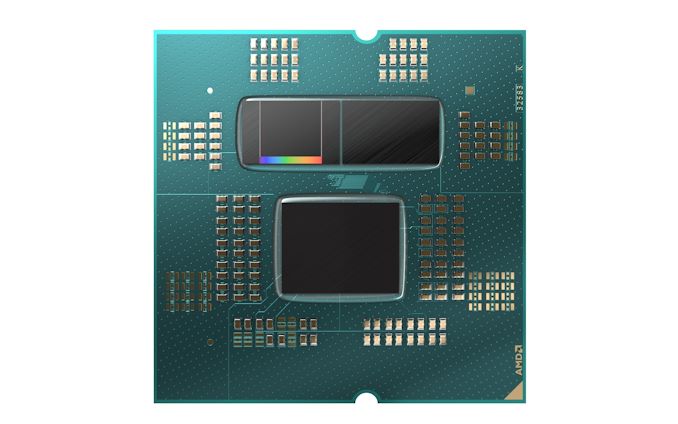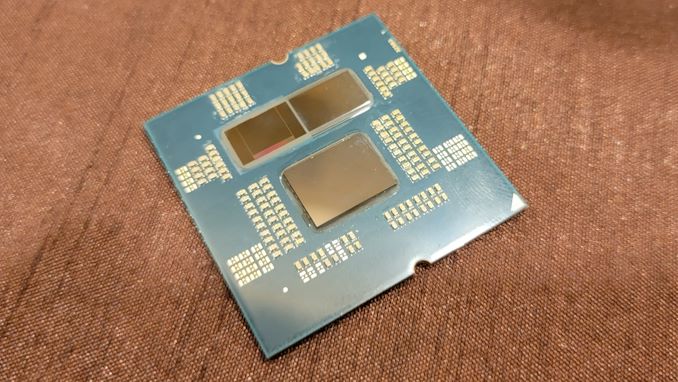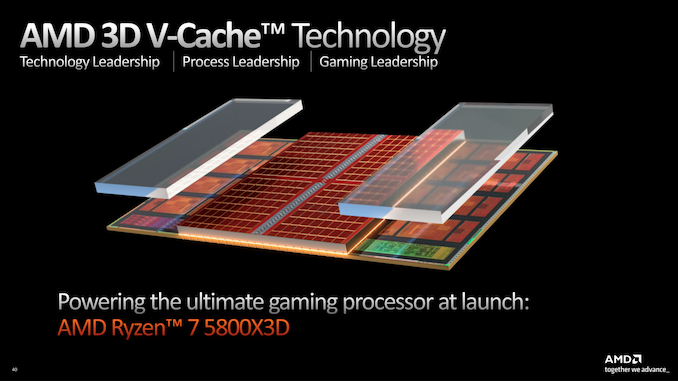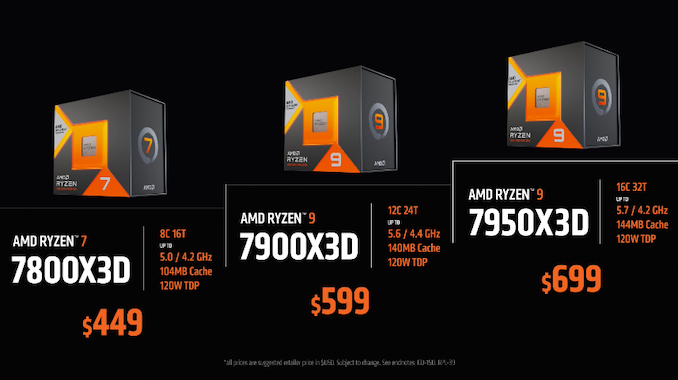AMD’s Ryzen 7000X3D Chips Get Release Dates: February 28th and April 6th, For $699/$599/$449
by Ryan Smith on February 1, 2023 9:45 PM EST- Posted in
- CPUs
- AMD
- X3D
- Ryzen 7000
- Raphael
- 3D V-Cache

AMD today has announced the launch date and prices for its eagerly anticipated Ryzen 7000X3D series processors. Aimed primarily at gamers, the company’s first L3 V-Cache equipped Ryzen 7000 processors will begin rolling out on February 28th, when the Ryzen 9 7950X3D and Ryzen 9 7900X3D go on sale for $699 and $599 respectively. This will be followed up by the Ryzen 7 7800X3D a bit over a month later, when it goes on sale for $449 on April 6th.
First announced to great fanfare during AMD’s CES 2023 keynote (and teased well before that), the Ryzen 7000X3D chips will be AMD’s second generation of consumer chips employing the company’s novel 3D stacked V-Cache technology. V-Cache allows AMD to stack a 64MB L3 cache die on top of their existing CCDs in order to expand the total L3 capacity of a Zen 3/4 CCD, going from 32MB to 96MB. And in the case of multi-CCD designs such as the Ryzen 9 7950X, bringing the total, chip-wide L3 cache pool to 128MB.
| AMD Ryzen 7000X/X3D Series Line-Up | |||||||
| AnandTech | Cores Threads |
Base Freq |
Turbo Freq |
L3 Cache |
TDP | Price (Street) |
Release Date |
| Ryzen 9 7950X3D | 16C / 32T | 4.2 GHz | 5.7 GHz | 128 MB | 120W | $699 | 02/28/23 |
| Ryzen 9 7950X | 16C / 32T | 4.5 GHz | 5.7 GHz | 64 MB | 170W | $583 | - |
| Ryzen 9 7900X3D | 12C / 24T | 4.4 GHz | 5.6 GHz | 128 MB | 120W | $599 | 02/28/23 |
| Ryzen 9 7900X | 12C / 24T | 4.7 GHz | 5.6 GHz | 64 MB | 170W | $444 | - |
| Ryzen 7 7800X3D | 8C / 16T | 4.2 GHz | 5.0 GHz | 96 MB | 120W | $449 | 04/06/23 |
| Ryzen 7 7700X | 8C / 16T | 4.5 GHz | 5.4 GHz | 32 MB | 105W | $299 | - |
| Ryzen 7 5800X3D | 8C / 16T | 3.4 GHz | 4.5 GHz | 96 MB | 105W | $323 | - |
Following the successful trial of the technology in the consumer space with AMD’s original Ryzen 7 5800X3D, which was released to positive acclaim back in the spring of 2022, AMD has developed a much broader lineup of V-Cache equipped Ryzen chips for this generation. This includes not only the 5800X3D’s direct successor, the 8 core Ryzen 7 7800X3D, but also, for the first time, chips employing multiple CCDs. These are the Ryzen 9 7900X3D and 7950X3D, which will offer 12 and 16 CPU cores, respectively.
Interestingly, AMD has gone for a non-homogenous design for these multi-CCD parts – rather than giving both CCDs V-Cache, AMD is only outfitting one of the CCDs with the extra L3 cache. The other CCD will remain a plain Zen 4 CCD, with its integrated 32MB of L3 cache. The unbalanced design, besides allowing AMD to control the costs of what’s still a relatively expensive technology to implement, will allow AMD to offer something close to the best of both worlds for their multi-CCD parts. The V-Cache equipped Zen 4 CCDs will offer 6 or 8 CPU cores backed by the massive L3 pool, for tasks that benefit from the larger cache size, while the vanilla Zen 4 CCDs will be unencumbered by the V-Cache, allowing them to clock higher for pure throughput workloads that wouldn’t benefit from the extra cache.
As with the original 5800X3D, AMD is aiming these chips at gamers in particular, as the complex, heavy-dataset nature of video games means they often benefit from having additional L3 cache on-hand. The 5800X3D was, depending on the game, around 15% faster than its vanilla Ryzen counterpart – at least so long as it wasn’t GPU limited. AMD is being a bit more coy this time around on making apples-to-apples comparisons against their regular Ryzen 7000 chips, so for now the only official performance figures available from AMD are pitting the chips against the 5800X3D. In lieu of that, a 15% improvement is a reasonable baseline given that the cache sizes haven’t changed in the last generation, but we’ll definitely want to take a closer look at the final chips to see if the additional L3 cache is as beneficial to Zen 4 as it was for Zen 3.
Back at their CES 2023 keynote, AMD announced the specifications for two-and-a-half of the chips, as well as an undetailed February launch date. With today’s announcement, AMD is finally filling in the rest of the details, as well as confirming that only part of the product stack is going to make that February launch date.

(Image Courtesy Tom's Hardware)
As previously noted, the Ryzen 9 7950X3D and Ryzen 9 7900X3D both launch on February 28th. The 16 core 7950X3D will hit the streets with a $699 price tag, while the 12 core 7900X3D will intro at $599. At current street prices, this represents roughly a $100 to $150 premium over the chips’ regular counterparts, with the 7950X selling for around $583, and the 7900X selling for around $444. Prices on AMD’s top AM5 chips have come down a decent bit since their 2022 launch, so the new X3D SKUs are coming in at similar launch prices as their non V-Cache counterparts. Put another way, whereas $699 would get you a 16 core 7950X in September, come February it will get you the same chip with an additional 64MB of L3 cache.
Other than benchmarks, at this point the only detail we don’t have on the 7950X3D and 7900X3D are the clockspeeds for the V-Cache equipped CCDs. AMD’s quoted turbo clockspeeds are for the vanilla CCD, so it’s unclear just how much clockspeeds have been lowered for the V-Cache CCD. But taking a hint from AMD’s sole single CCD X3D part, the 7800X3D, we see that part has a top clockspeed of just 5.0GHz. So we’d expect something similar for the V-Cache CCDs on the Ryzen 9 parts.
Speaking of the Ryzen 7 7800X3D, we finally have the full specifications on AMD’s most straightforward X3D part. Back in January AMD hadn’t locked down the base clockspeeds on this part, but as of today we finally have the answer: 4.2GHz. The chip will, in turn, be able to turbo as high as 5.0GHz as previously noted.
The cheapest of the Z3D parts, with a price tag of $449, the 7800X3D will also be the laggard of the group, with the chip not launching until April 6th. AMD has not explained the gap in launch dates, but it’s reasonable to assume that AMD is prioritizing the assembly and shipping of their more expensive Ryzen 9 SKUs. In any case, at current street prices the 7800X3D will carry a $150 premium over the $299 7700X, making it a full 50% more expensive, assuming these street prices hold through April. This happens to be the same price the 5800X3D launched at, so AMD is technically just holding the line here, but it does underscore how price cuts on the rest of the Ryzen 7000 lineup have made the standard chips very competitive on a price/performance basis.
In any case, we’ll have more on AMD’s first V-Cache equipped Zen 4 chips later this month. Besides taking an in-depth look at the performance improvements brought about by the larger L3 cache, the other major factor driving performance is going to be the Windows thread scheduler. As this is AMD’s first asymmetric Ryzen CPU, it will be up to Windows and AMD’s chipset driver to figure out which CCD to place threads on for the 7950X3D/7900X3D. So this month’s launch is going to require that AMD’s hardware and software offerings are in sync in order for the company to make a good first impression.












64 Comments
View All Comments
nandnandnand - Thursday, February 9, 2023 - link
Premium quad-cores don't make sense with AMD's 8-core chiplet. It's dead, get it out of your head.7600X3D would be nice, but AMD would rather keep X3D prices higher, especially if they all beat the 13900KS on average.
If would be perfect if they could use a defective cache chip to make a 7600X3D with somewhere between 32 and 96 MB, and launch that at a later date. Maybe at that $250 price point.
abufrejoval - Sunday, February 19, 2023 - link
As I understand it, there is two major reasons for binning: Outright defects and excess voltage requirements (or clock limits) due to borderline connection driving a chip beyond the allowable power boundary.I am assuming that outright defects with "defect craters" taking out full cores have become very rare indeed and that the second type is far more common, especially near the edges or when masks need cleaning. Most 6-core CCDs might actually contain 8 functional cores, but get the worst two voltage or clock offenders cut to fit inside the permissible power envelope and boost range.
A fabbing process that regularly results in half of the 8 cores designed into a CCD to get evicted, results in 100% cost and below 50% revenue. And only if the internal L3 cache survives, which is incidentally already uses much more surface area than the cores themselves.
Latching the 64MB V-cache addon on such a broken chip can only add marginal margin at full 3D cost, so it makes absolutely no sense economically.
AMDs cost structure is based on reusing a single basic CCD design across the largest range of SoCs, which simply doesn't include quad core CPUs any more.
A separate 4 core design might perhaps deliver half size CCD and twice as many of them, but a finished SoC would be difficult to produce at 50% cost while they are far too likely to sell at less than that.
Intel's internal charging model doesn't need to account for silicon surface area consumed as they go to these small and low revenue dies, often with large iGPUs thrown for next to nothing.
But AMD has to pay for every square millimeter consumed and needs to make the highest revenue from that to thrive. It's more likely futher generations of CCDs will go to even higher minimal design core counts, quad core survivors might still collect like iGPU-less APUs did, but they are more likely to be sold as scrap to OEMs e.g. in China than become an official SKU.
Well, there are reports of 8-core SKUs made from dual quad survivor CCDs... but again, that's recycling not design. And no one will fit V-cache tiles on known crap.
abufrejoval - Sunday, February 19, 2023 - link
I doubt something like an OS scheduler could properly decide if a process is better served via a core with more cache or higher clocks: it requires extensive profiling data and something of an expert system to make and review such decisions and nobody would accept a scheduler that might need more time than what fits into a hardware clock tick.True, you could fit evaluating an external bias collected by such an expert system into a modified scheduler, but a "consumer friendly" qualified decision maker will need to come as an app or service, which is fed with game profile data previously collected and perhaps enhanced via runtime data collection (and likely little respect for the GDPR).
Perhaps a basic mode would simply consist in assigning each application a primary CCD type, but in a complex game different processes or even thread might actually be better served by one type or the other.
One thing already seems pretty sure to me: there will be endless debates on right, better and wrong with plenty more opinion than tangible benefits in real games.
While I consider the mixed type CCD approach technically brilliant, I'm not so sure it will survive publicity that doesn't understand it.
Lawzy - Monday, February 27, 2023 - link
Nice and way overkill. Depends on your use though, if someone is playing on 1080 @ 144 even the 5600x and 2070 is more plenty. Want more add 3070.Same for Intel those I9s and massive cards are a waste for the majority of gamers. Again depends on use and how much you want to blow for useless unnoticed performance (waste)